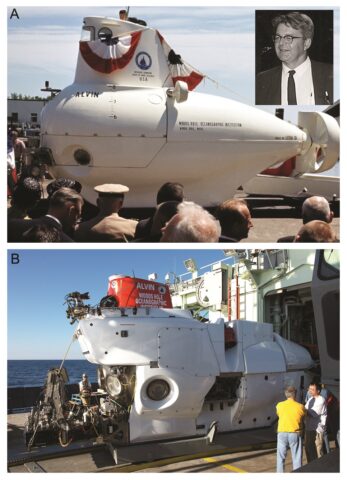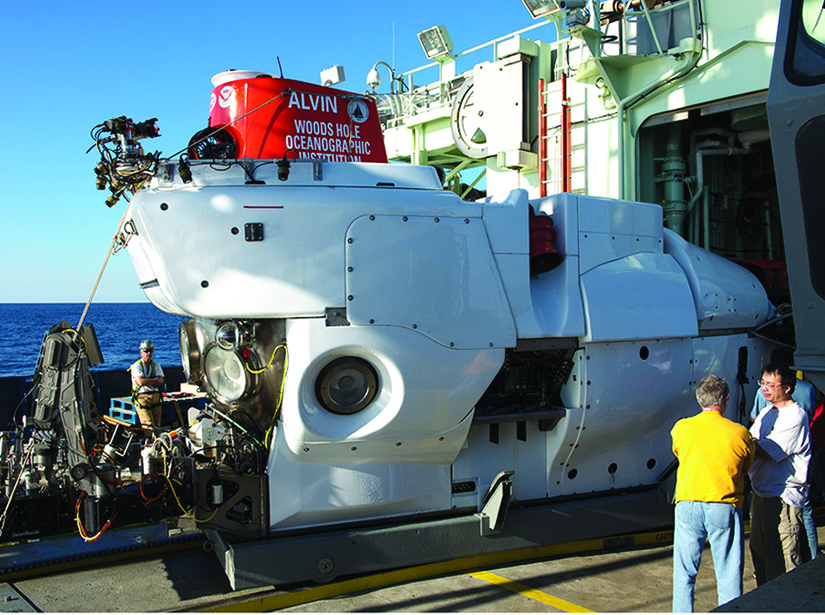This week the Deep Submergence Vehicle (DSV) Alvin, the world’s first deep-diving submarine and the only one dedicated to scientific research in the United States, celebrates its 50th anniversary.
Owned by the U.S. Navy and operated by the Woods Hole Oceanographic Institution (WHOI), Alvin has provided unprecedented access to the deep ocean, enabling extensive observations as well as data and sample collection for investigating physical, chemical, geological, and biological processes. Its pioneering work has led to rapid technological developments in deep submergence vehicles that have greatly expanded scientists’ abilities to conduct research throughout this vast and remote environment.
Beginnings of a Human Presence in the Deep Ocean
Alvin was the dream of one individual who envisioned scientists using submarines for deep ocean exploration.
On 29 February 1956, 103 scientists met in Washington, D. C., to discuss how to investigate the ocean depths. A young WHOI geophysicist, Allyn Vine, suggested that people should go down into the ocean rather than try to conduct research by remote methods.
At the meeting, Bob Dietz from the Office of Naval Research (ONR) and Jacques Piccard (who had dived to a depth of almost 2 miles with his father in 1953 in the bathyscaph Trieste) gave presentations on Trieste’s capabilities. Despite mixed opinions, the participants passed a resolution to develop a national program “aimed at obtaining…undersea vehicles capable of transporting men and their instruments to the great depths of the ocean” [von Arx, 1957].
ONR sent a delegation, including Vine, to Italy to see Trieste, and in 1958, the U.S. Navy bought it for $250,000. In this vehicle, with a new observers’ sphere, Piccard and Navy lieutenant Don Walsh made their historic dive to the Mariana Trench in January 1960. However, Trieste soon proved too large and cumbersome for routine operations throughout the oceans. It became clear that a smaller, more maneuverable deep-diving vehicle was needed.
Design and Construction of Alvin

Alvin arose from a design by Harold “Bud” Froelich, an engineer from General Mills, for a vehicle named Seapup. The newly formed WHOI Deep Submergence Group as well as Charles Momsen (then the chief of undersea warfare at ONR) liked Seapup’s design, and WHOI requested bids to build a submersible based on that design. The Deep Submergence Group had already started using the name Alvin for the new submersible to honor the vehicle’s prime mover and inspiration, and the name stuck.
General Mills won the bid for $498,500 to build a submersible to dive to 6000 feet (~2000 meters) and contracted Hahn and Clay in Houston, Texas, to fabricate three 6-foot diameter HY-100 steel spheres (the other two were later used for the Navy’s Sea Cliff and Turtle DSVs). The six hemispheres were forged at Lukens Steel Company in Coatesville, Pa., in December 1962 and were welded into three spheres at Hahn and Clay.
On 5 June 1964, a commissioning ceremony for Alvin was held on the dock in Woods Hole, Mass. (Figure 1a). Deservedly, Vine and Froelich accompanied pilot Bill Rainnie on the first two dives.
The following year, Alvin’s first tender—a catamaran named Lulu after Vine’s mother—was constructed from a pair of surplus Navy pontoons. Alvin sailed on Lulu until 1984 and then was modified to a single-point lift system to be transferred to the R/V Atlantis II. Since 1997, when that vessel was retired, Alvin has operated from the R/V Atlantis.
Alvin’s Decades of Ocean Exploration
Alvin’s first major undertaking was in response to an urgent request from the U.S. Navy in early 1966. An Air Force B-52 bomber had collided with a tanker over Spain, dropping a hydrogen bomb in the Mediterranean Sea. A 2-month search operating from a landing ship dock was successful and proved Alvin’s ability to conduct operations at the seafloor.
In 1971, the head of the French Centre National pour l’Exploitation des Oceans proposed a joint U.S.-French expedition with WHOI to explore the Mid-Atlantic Ridge using human-occupied submersibles. In 1972, with the approval of the U.S. National Academy of Sciences but amid doubts by many scientists about how useful submersibles might be, funds were granted for Project FAMOUS (French-American Mid-Ocean Undersea Study) to dive to about 3000 meters on the Mid-Atlantic Ridge between 36°N and 37°N. In 1973, Alvin’s steel personnel sphere was replaced with a titanium one that extended Alvin’s diving range from 6000 feet (~2000 meters) to 12,000 feet (~3650 meters). This was the first time in history that scientists descended to a mid-ocean ridge [Ballard et al., 1975]. This successful project proved that submersibles could effectively explore the seafloor and marked the beginning of a new era of seafloor exploration.
Alvin is perhaps most celebrated for investigations in 1977 and 1979 of seafloor hydrothermal systems and their associated chemosynthetic ecosystems, including giant tubeworms and clams, on the Galápagos Rift, one of the most profound discoveries of the late 20th century [Corliss et al., 1979]. The existence of distinct seafloor chemosynthetic ecosystems (Figure 2a), which thrive on energy stored in reduced chemicals from the Earth rather than energy from the Sun, revolutionized our views of where and how life can exist on Earth and perhaps elsewhere in the universe.
Discovering Hydrothermal Vents and Photographing the Titanic

In 1979, at 21°N on the East Pacific Rise, scientists in Alvin discovered black smokers (Figure 2b) discharging high-temperature (350°C), acidic, reducing, and metal-rich fluids [Spiess et al., 1980]. This marked the beginning of numerous Alvin expeditions that discovered hydrothermal vents along the global mid-ocean ridge system in the Pacific and Atlantic Oceans.
One project particularly riveted the attention of the general public and made Alvin a household word: its photographic documentation of the wreck of RMS Titanic discovered in 1985 with a towed camera system. A year later, on its dives to the Titanic (Figure 2c), Alvin deployed a prototype remotely operated vehicle, Jason Jr., that was able to penetrate the wreck and take stunning images of the sunken vessel.
Over the following decades, Alvin discovered new seafloor environments that harbored other chemosynthetic communities. Since 1983, when scientists in Alvin discovered chemosynthetic communities at cold seeps on the Florida Escarpment [Paull et al., 1984], Alvin has supported numerous investigations of hydrocarbon and saline seeps on the continental slope of the Gulf of Mexico. Although the underlying conditions that drive seeps differ from those of hydrothermal vents, chemical-rich fluids at seeps similarly provide energy to sustain lush microbial mats and communities of tubeworms, mussels, and clams [Cordes et al., 2009].
The Lost City Hydrothermal Field
More recently, Alvin was part of an expedition that discovered the Lost City hydrothermal field on 1.5-million-year-old crust at 30°N, Mid-Atlantic Ridge, where seawater reacts with mantle rock (peridotite) to produce methane and hydrogen and build 60-meter-tall carbonate chimneys [Kelley et al., 2001]. Credit for these discoveries should be shared with the Alvin pilots whose experience from many dives positions them well to recognize something “different” at the seafloor.
In 2010, Alvin took part in a national response to the Deepwater Horizon oil spill disaster. The expedition examined dead and dying corals discovered just 7 miles from the well head. Alvin worked in tandem with the autonomous underwater vehicle Sentry to gauge the response of benthic communities to oil exposure in the deep Gulf of Mexico [White et al., 2012] (Figure 2d).
Alvin in 2014 and Beyond
In December 2010, after 4664 dives, Alvin was taken out of service to undergo a major upgrade funded by the National Science Foundation and WHOI. A new, larger, titanium, 6500-meter personnel sphere with five, rather than three, viewports was integrated into Alvin’s modified frame. The upgraded Alvin is equipped with fiber optic penetrators, a new command-and-control system, improved lighting and high-definition imaging, and increased data-logging capabilities. The new Alvin (Figure 1b) returned to service in March 2014, picking up where it left off with studies in the Gulf of Mexico. Diving to 6500 meters awaits development of batteries with greater energy density suitable for a human-occupied vehicle. Once that capability is realized, Alvin’s research potential will be expanded to being able to work in 98%, rather than 65%, of the ocean.
When Allyn Vine first conceived of using submarines for scientific research, he could never have predicted the discoveries that have been made as a result of sending humans to explore the deep ocean. As Vine observed, “I find it difficult to imagine what kind of instrument should have been put on the Beagle instead of Charles Darwin” [Vine, 1957]. In the same spirit, Alvin will continue to be a workhorse for exploring Earth’s deep oceans for decades to come.
References
References
Ballard, R. D., et al. (1975), Manned submersible observations in the FAMOUS area, Mid-Atlantic Ridge, Science, 190, 103–108.
Cordes, E. E., D. C. Bergquist, and C. R. Fisher (2009), Macro-ecology of Gulf of Mexico cold seeps, Annu. Rev. Mar. Sci., 1, 143–168.
Corliss, J. B., et al. (1979), Submarine thermal springs on the Galapagos Rift, Science, 203, 1073–1083.
Kelley, D. S., et al. (2001), An off-axis hydrothermal vent field near the Mid-Atlantic Ridge at 30°N, Nature, 412, 145–149.
Paull, C. K., et al. (1984), Biological communities at the Florida Escarpment resemble hydrothermal vent taxa, Science, 226, 965–967.
Spiess, F. N., et al. (1980), East Pacific Rise: Hot springs and geophysical experiments, Science, 207, 1421–1433.
Vine, A. C. (1957), Vehicles as instruments for oceanographers, in Proceedings of the Symposium on Aspects of Deep Sea Research, Feb. 29 – March 1, 1956, edited by W. S. von Arx, Publ. 473, pp. 98–104, Comm. on Undersea Warfare, Natl. Res. Counc., Natl. Acad. of Sci., Washington, D. C.
von Arx, W. S. (Ed.) (1957), Proceedings of the Symposium on Aspects of Deep Sea Research, Feb. 29 – March 1, 1956, Publ. 473, 176 pp., Comm. on Undersea Warfare, Natl. Res. Counc., Natl. Acad. of Sci., Washington, D. C.
White, H. K., et al. (2012), Impact of the Deepwater Horizon oil spill on a deep-water coral community in the Gulf of Mexico, Proc. Natl. Acad. Sci. U. S. A., doi:10.1073/pnas.1118029109.
Author Information
Susan E. Humphris, Christopher R. German, and J. Patrick Hickey, Woods Hole Oceanographic Institution, Woods Hole, Mass.; email: [email protected]
© 2014. American Geophysical Union. All rights reserved.
© 2014. American Geophysical Union. All rights reserved.

